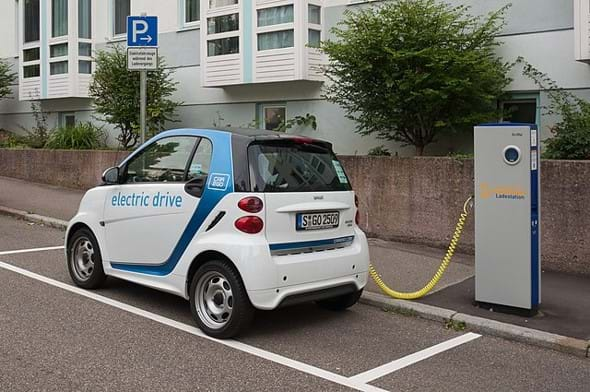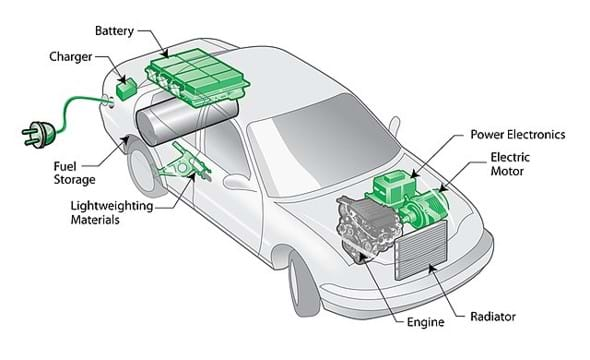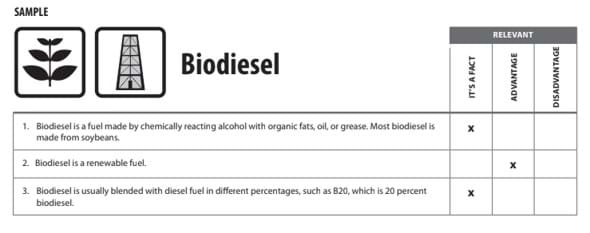Quick Look
Grade Level: 9 (9-12)
Time Required: 1 hours 30 minutes
(two 45-minute periods or one 90-minute block)
Expendable Cost/Group: US $0.00
Group Size: 4
Activity Dependency: None
Subject Areas: Physical Science, Problem Solving, Science and Technology

Summary
Student teams learn about transportation fuels and then are assigned to represent the different fuels. Working cooperatively, the students develop arguments on the merits of their fuel over the others. One debate will be conducted on fuels for personal vehicles.Engineering Connection
Student teams learn about transportation fuels, then are assigned to represent the different fuels. Working cooperatively, the students develop arguments on the merits of their fuel over the others. One debate will be conducted on fuels for personal vehicles.
Learning Objectives
After this activity, students should be able to:
- Outline their current knowledge and conduct basic research on three different vehicle fuel options (gasoline, electric, hybrid), including the pros and cons of each fueling type.
- Align facts and provide an argument on information related to the assigned topic using claims, evidence, and reasoning.
Educational Standards
Each TeachEngineering lesson or activity is correlated to one or more K-12 science,
technology, engineering or math (STEM) educational standards.
All 100,000+ K-12 STEM standards covered in TeachEngineering are collected, maintained and packaged by the Achievement Standards Network (ASN),
a project of D2L (www.achievementstandards.org).
In the ASN, standards are hierarchically structured: first by source; e.g., by state; within source by type; e.g., science or mathematics;
within type by subtype, then by grade, etc.
Each TeachEngineering lesson or activity is correlated to one or more K-12 science, technology, engineering or math (STEM) educational standards.
All 100,000+ K-12 STEM standards covered in TeachEngineering are collected, maintained and packaged by the Achievement Standards Network (ASN), a project of D2L (www.achievementstandards.org).
In the ASN, standards are hierarchically structured: first by source; e.g., by state; within source by type; e.g., science or mathematics; within type by subtype, then by grade, etc.
International Technology and Engineering Educators Association - Technology
-
Evaluate ways that technology can impact individuals, society, and the environment.
(Grades
9 -
12)
More Details
Do you agree with this alignment?
Materials List
Each group needs:
- A set of Vehicle Fuels Info Sheets (Electric Vehicle Info Sheet, Gasoline Vehicle Info Sheet, and Hybrid Vehicle Info Sheet) per team
- 1 Vehicle Fuels Debate Worksheet per student
- 1 Vehicle Fuels Debate Game Board per team
- A set of YES/NO cards for each judge
Worksheets and Attachments
Visit [www.teachengineering.org/activities/view/ced-2706-transportation-fuels-debate-engineering-design] to print or download.Introduction/Motivation
Today we will debate the pros and cons of three transportation fuels: gasoline, electricity, and hybrid electric. Working cooperatively, we will develop arguments on the merits of each fuel type over other fuel types. We will then debate on the pros and cons of different fuels for our personal vehicles.

Procedure
Background
Transportation plays a sizable role in our greenhouse gas emissions with transportation contributing over 33% of CO2 emissions. Electricity generation is the other major contributor to CO2 emissions, with over 36%. A person's transportation and day-to-day electrical consumption decisions make up a big part of their carbon footprint, due to the burning of fossil fuels to supply electricity and transportation fuels.
- All transportation fuels have economic, environmental, and societal advantages and disadvantages.
- Economic and environmental impacts are factors in determining the transportation fuels we use.
- Societal needs, personal beliefs, and changes to the quality of life are important considerations in determining the transportation fuels we use.
With the Students
Part 1: Vehicle Fuels Research
- Introduce the Transportation Fuels Debate to the class, using the following concepts as a guide:
- We use petroleum products for most transportation fuels today.
- Petroleum-based fuels produce emissions that can have a detrimental effect on air quality.
- There are many conventional and alternative transportation fuels.
- Some transportation fuels affect the environment more than others.
- Some transportation fuels are widely used, while others are not.
- Some transportation fuels are more expensive than others.
- Some transportation fuels are more suitable for fleet vehicles, others for personal vehicles.
- Assign the students to one of the fuel debate groups (gasoline, electricity, hybrid).

- Distribute a copy of each of the Vehicle Fuels Info Sheets (Electric Vehicle Info Sheet, Gasoline Vehicle Info Sheet, and Hybrid Vehicle Info Sheet) and one Transportation Fuels Debate Worksheet to each student.
- Demonstrate the procedure for using the Vehicle Fuels Info Sheets to complete the Transportation Fuels Debate Worksheet.
- Have the students work together as they research their fuel type and complete their fuels debate worksheet for their assigned fuel type. Provide student support as needed
- Optional: Assign students to complete their fuel debate worksheet for their assigned fuel type (or all fuel types) as homework.

- Select a panel of judges. The teacher can serve as the judge, or each group can select one person from their team to serve as a judge. Each judge is given a YES/NO card.
- Begin the fuels debate game by giving the teams the following instructions:
The object of this game is to be the first team to reach the top of the Game Board. The game is played in rounds, with each team given the opportunity to move its token up by giving an advantage of its fuel. You may instead choose to move an opponent’s token down by giving a disadvantage to the opponent’s fuel.
- The teams will present their advantages or disadvantages to a panel of judges. If a team gives an advantage of its fuel and the judges agree, then the team moves up one space. An opposing team can object to the judge’s decision. The opposing team must convince the judges that the statement is not an advantage. The team that stated the advantage will then have the opportunity to defend its position. The judges will vote again and one of two things will happen. The judges may vote in favor of the defending team. In this case, the defending team maintains its new position and the opposing team moves down one space. Or the judges may decide whether the statement is a disadvantage or irrelevant. In this case, the defending team moves back to its original position.
- If a team states a disadvantage to try to move an opposing team down, then the opposing team can defend itself without penalty.
- Ask the first team to give an advantage or disadvantage. The action continues until one team reaches the top line, until time is called, or until each team has had the opportunity to begin a round. Each team should have the opportunity to begin a round.
- After the game, point out that all transportation fuels have advantages and disadvantages. Ask the class the following questions:
- Was there an obvious winner in either game?
- If the game continued, would the results change? Why or why not?
- Why do we use transportation fuels that have negative impacts on the environment?
- What are some other factors that we need to consider in our choice of transportation fuels?
- Have the students write short essays answering the following questions:
- What was the purpose of playing this game?
- What were the important concepts you learned from playing the game?
- What fuel would you most likely use for a personal vehicle and why?
Vocabulary/Definitions
hybrid vehicle: Vehicle that can be powered by an electric motor that draws electricity from a battery and is capable of being charged from an external source
alternative fuels: Fuels other than gasoline for powering motor vehicles, such as natural gas, methanol, or electricity.
electric vehicle: Vehicle that can be powered by an electric motor that draws electricity from a battery and is capable of being charged from an external source.
gasoline: Refined petroleum used as fuel for internal combustion engines.
ICE vehicle: Vehicle powered by an internal combustion engine and one or more electric motors, which use energy stored in batteries.
Assessment
Post-Activity (Summative) Assessment
Making Sense Assessment: Have students reflect on the science concepts they explored and or the engineering skills they used by completing the Making Sense Assessment.
Troubleshooting Tips
- Have students use the internet for current information to cross-reference vehicle fuel info sheets.
Additional Multimedia Support
Additional vehicle fuels resources:
Subscribe
Get the inside scoop on all things TeachEngineering such as new site features, curriculum updates, video releases, and more by signing up for our newsletter!Other Related Information
This resource is adapted from the National Energy Education Development (NEED.org) “Transportation Fuels Debate” (2012) by Jennifer Taylor
Copyright
© 2022 by Regents of the University of Colorado BoulderContributors
Jennifer TaylorSupporting Program
Integrated Teaching and Learning Program, College of Engineering, University of Colorado BoulderAcknowledgements
This curriculum was developed under National Science Foundation grant numbers 1941524 and 1941701. Any opinions, findings, and conclusions, or recommendations expressed in this material are those of the authors and do not necessarily reflect the views of the National Science Foundation.
Last modified: October 14, 2024






User Comments & Tips